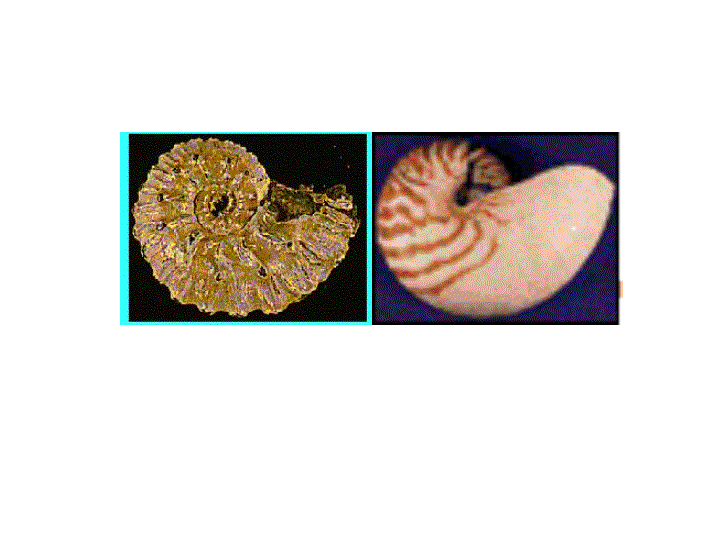
Invertebrate Paleontology Lab #8
Mollusca II: Cephalopoda, Polyplacophora, and Scaphopoda
Read BEFORE Coming to Lab: Benton & Harper, p. 344-360

Read BEFORE Coming to Lab: Benton & Harper, p. 344-360
Introduction
This week we will continue with our examination of the Molluscan Phylum by studying the Classes Cephalopoda, Polyplacophora, and Scaphopoda. Although the latter two classes are relatively uncommon in the fossil record, the Cephalopod Class is extremely well represented. Cephalopods are marine predators, and have a long Phanerozoic history that begins in Late Cambrian time. (You may remember seeing the straight-shelled nautiloid cephalopods in the Ordovician rocks of Caesar's Creek). The Cephalopods also represent one of the best examples of Guide or Index fossils. Indeed, the Late Paleozoic (Devonian-Permian) and the Mesozoic, particularly the Jurassic, is biostratigraphically zoned on the basis of the cephalopod fossil record. This means that for Geologists, the Cephalopod Class is extremely valuable, and certain basic trends in this class through time should be well learned. We will begin with the Cephalopods, therefore, since they play such an important role in the paleoecology and biostratigraphy of the Phanerozoic.
Class Cephalopoda
This class composes the largest and most intelligent of the molluscs, and as a class, the group is marked by 1) modification of the foot to form a ring of tentacles around the mouth, 2) modification of the mantle and mantle cavity to form a siphon, fins, and jet propulsion system for swimming backwards, 3) replacement of a radula with a beak, 4) a large brain and large eyes with exceptionally large optic nerves. In the fossil record, many cephalopods were externally shelled, although most today have lost that shell, or carry only a stiffening rod or internal shell. For those with external shells, the shell could be straight (orthoconic) or coiled (planispiral in an increasing logarithmic spiral). Shell growth begins with a tiny chamber called the protoconch, and each chamber or camera is added on sequentially, separated from eachother by a shell wall called the septum. The last chamber, which is where the animal is living, is called the body chamber. The entire shell, (beginning just after the protoconch and continuing to just before the body chamber) is called the phragmocone. Connecting each of the septa is a fleshy tube that passes through the septal walls called the siphuncle, which through osmotic regulation can adjust the fluids and gases in the chambers, which in turn affects the buoyancy of the organism. In some cases, as in the Nautiloidea and the Endoceratoidea, the siphuncle passes through the central part of the septa, whereas in other cases, as in the Ammonoidea and the Bactritoidea, the siphuncle passes through the lower (ventral) area of the septa. The line on the inner shell wall indicating the presence of a septal wall is called the suture.
Major Subclasses
Subclass Nautiloidea (Late Cambrian? Ordovician-Recent)
Early forms show straight shells, with later forms showing strong
planispiral
shapes. Septal walls (and sutures) are straight, siphuncle passes
through the central part of the septal walls, often calcareous deposits
are observable in the chambers that probably served as ballast.
Only
1 living genus known today, and this is the genus Nautilus (pictured at
top of page).
Subclass Endoceratoidea (Ordovician)
Large, straight shelled Ordovician predators, with straight septal
walls and sutures, and large siphuncle passing through ventral (lower)
part of septal walls. Calcareous deposits in conical shaped
mounds
often observable formed in the siphuncle.
Subclass Bactritoidea (Ordovician-Triassic)
Small, straight shelled forms with a bulb like protoconch. Septal
walls and sutures slightly curved in adult chambers, siphuncle passes
through
ventral (lower) part of septal walls. No calcareous deposits
associated
with siphuncle or chambers.
Subclass Ammonoidea (Devonian-Cretaceous)
Largest subclass of cephalopods. Ammonids can be straight
shelled,
but most forms are planispirally coiled. Siphuncle is ventral
(low).
Chief taxonomic feature of this large group is the variation in the
suture
patterns. The patterns show a folded, curving line that is marked
by saddles and lobes (see diagrams below). Most Paleozoic
forms have a Goniatitic suture, where up to 8 saddles and lobes
occur in a line, often with a zig-zag look. Beginning in Triassic
time, these sutures become more complex, and are marked by U-shaped
saddles and lobes with tiny folds, called Ceratitic
sutures.
Jurassic
and Cretaceous ammonoids had crenulations and folds in
both the
lobes and the saddles, and these are called Ammonitic sutures.
The complexity of these sutures is the basis for taxonomic
classification
within the group.
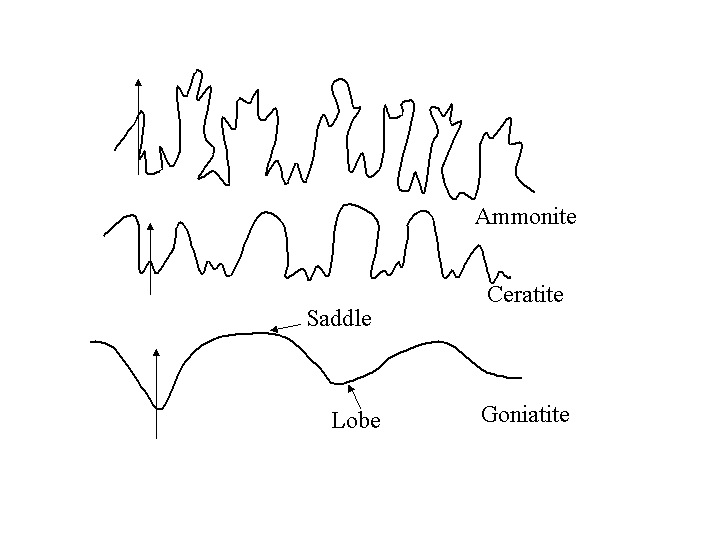
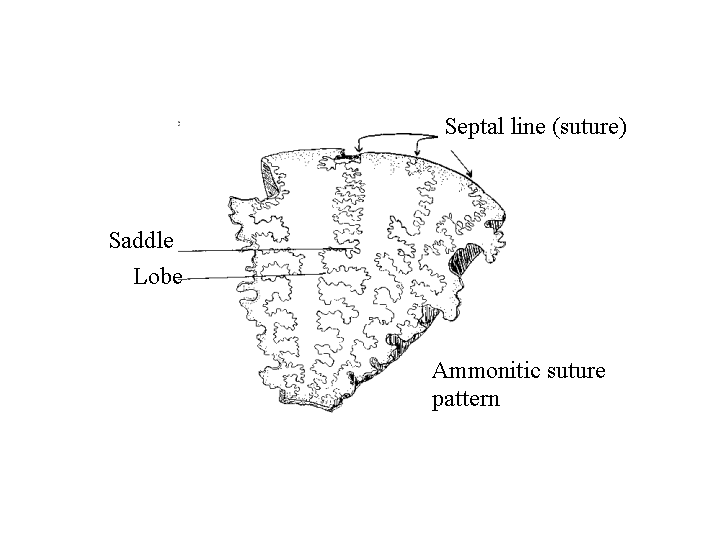
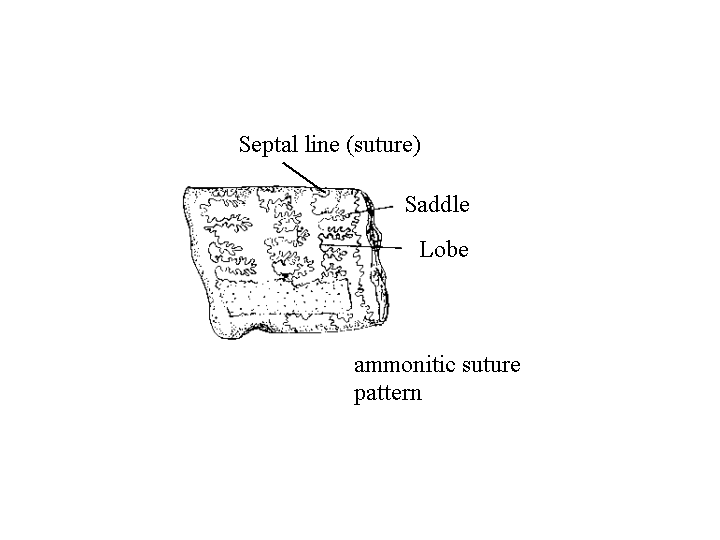
Part I. Draw 4 different fossil cephalopods, labeling the suture
line, the chamber, the phragmocone, the guard (or rostrum)
(if you have a Belemnite), and the saddles and lobes (if you
have
an ammonoid - say what kind of suture pattern is
present:
goniatite, ceratite, or ammonite). Indicate the Genus, Subclass,
and Range if that information is available on the
specimen.
20 pts.
Subclass Coleoidea (Carboniferous-Recent)
With the exception of Nautilus (Subclass Nautiloidea), all the living
cephalopods (squids, cuttlefish,octopus) are in this subclass.
The
shell is reduced ("cuttlebone"-a thin internal shell in cuttlefish),
"pen"
in squid), or completely gone (octopus). A well known group from
Jurassic and Cretacous time is the fossil Belemnite group, now
extinct.
The solid calcite guard (also known as a rostrum), a brown, bullet shaped ballast structure
is
typically preserved in great abundance, particularly in Cretaceous
marine
rocks.
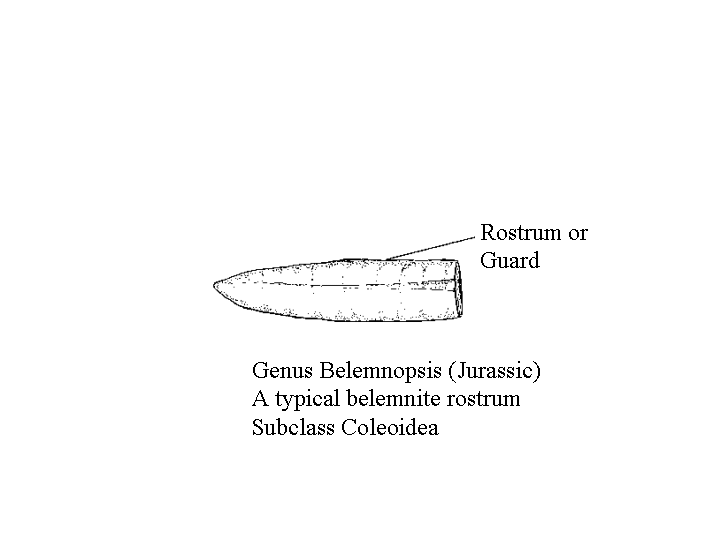
Class Polyplacophora (Ordovician-Recent)
This group is best known from the modern Chitons, or
Amphineura,
that live in shallow rocky intertidal environments. They are
characterized
by a covering of 8 interlocking calcite plates, all articulated
so that the animal can roll up like a pill bug if disturbed. A
marginal
band known as the girdle is formed by the mantle. The
chitons
have a radula composed of magnetite, which is extremely
efficient
at abrading rock surfaces and removing the seaweed and algae, upon w
hich
the animal feeds. In the fossil record, the disarticulated plates
are often found in nearshore environments-rarely is an entire chiton
found
preserved.
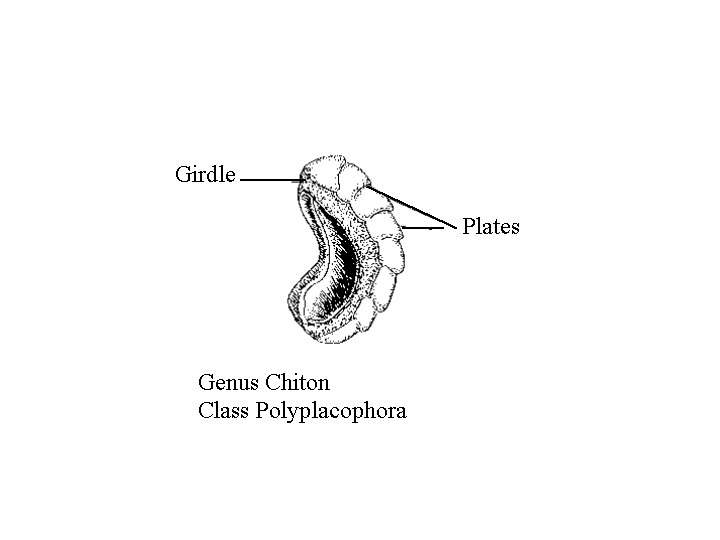
Class Scaphopoda (Ordovician-Recent)
These are the tusk shells, formed by a very small mollusk with
tentacles
that predates upon forams and other small benthic organisms in the
marine
sandy muds. Although most forms are very small, during the
Pennsylvanian,
some Scaphopods reached lengths of about 2 feet.
| Basic Facts to Know about Mollusks: They are |
|
| 1. | Eukaryotes |
| 2. | Metazoans with organs, true tissues, nervous, muscular, and reproductive systems |
| 3. | characterized by an aragonitic or calcite shell, precipitated from the outer layer of the mantle (some internalize the shell) |
| 4. | characterized by Bilateral Symmetry |
| 5. | Excellent index fossils: widely distributed, well preserved, easily identified, rapidly evolving |
| 6. | separate sexes or hermaphroditic, with sexual reproduction, Larvae are planktonic (mostly) |
| 7. | found in all known oxygenated aquatic environments, including deep marine, fresh water, groundwater, springs and wetlands |
| 8. | found in many terrestrial environments (you may have met them in the garden this summer...) |
| 9. | found to filter feed, bore, directly feed on sediments, hunt (carnivores), scavenge, or parasitize. |
Image ID: nur01010, National
Undersearch
Research Program (NURP) Collection, NOAA
Location: Temperate Atlantic
Ocean,
offshore Cape Hatteras.
Photo Date: 1989
September
Photographer: T. Schaff
Credit: OAR/National Undersea
Research
Program (NURP); North Carolina State University
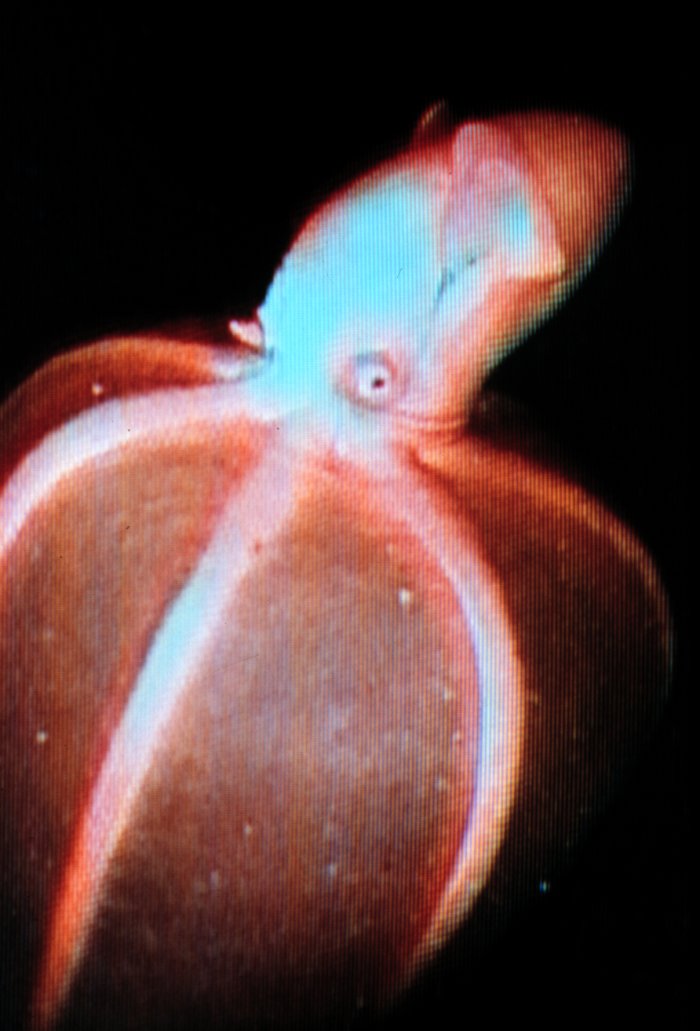
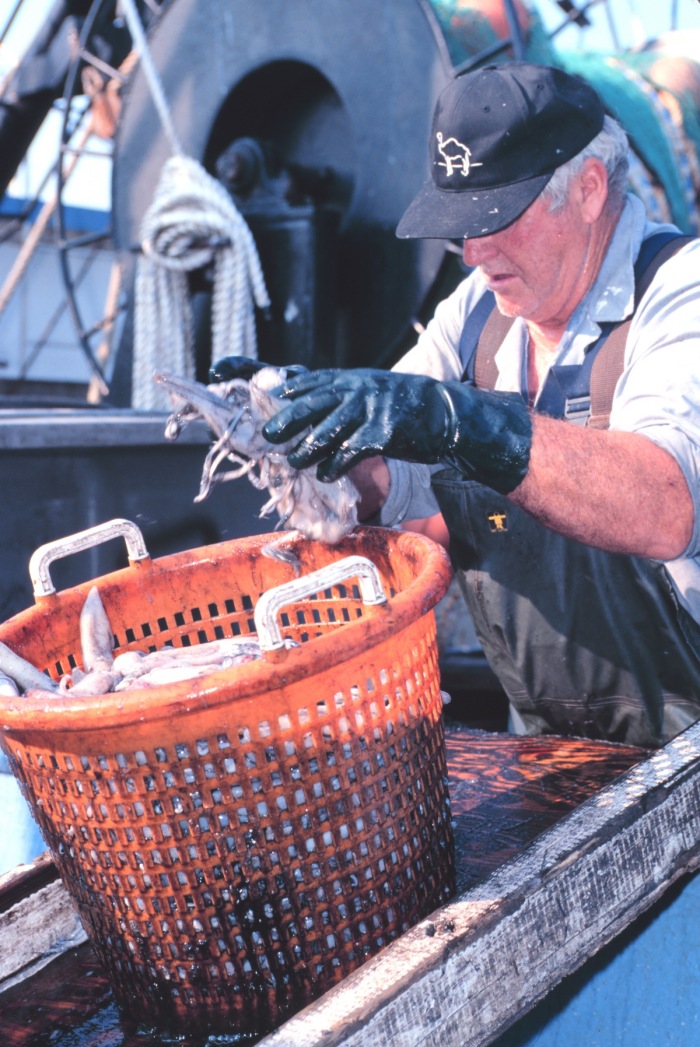
Offloading squid from the F/V ATLANTIC TRAVELLER at Co-op Seafood
Market dock.
Image ID: fish1029, Fisheries Collection, NOAA
Location: Point Pleasant, New Jersey, Photographer: Edward J.
Pastula,
NMFS
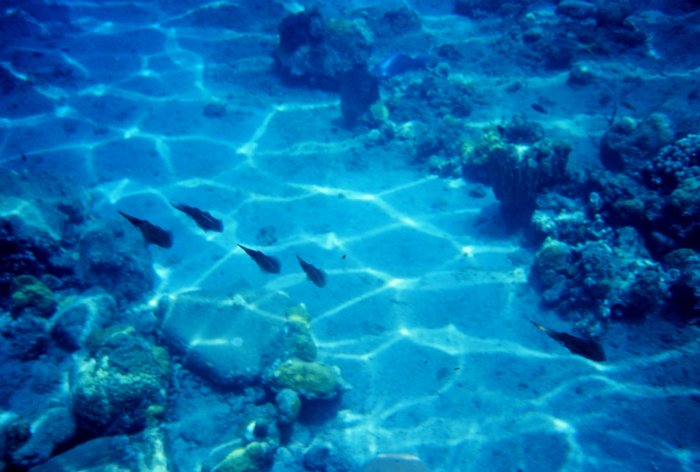
Squid travelling in formation
Image ID: reef1502, The
Coral
Kingdom Collection, NOAA
Location: St. Lucia,
Caribbean
Sea
Photo Date: 1988 August,
Photographer: Dr. Anthony R. Picciolo, NOAA NODC
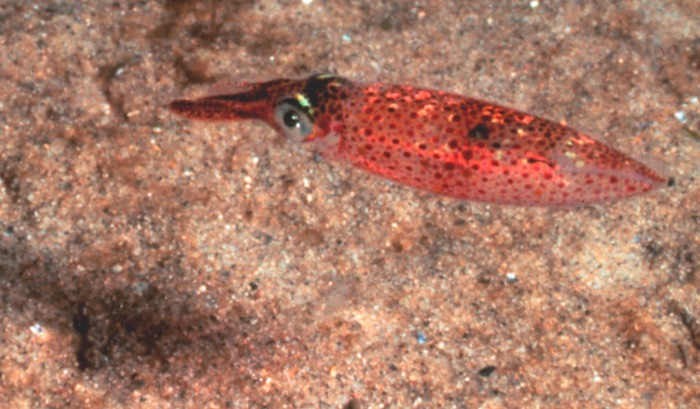
A squid - Illex illecebrosus -
cruising over a sandy area of the bank
Image ID: sanc1001, Sanctuary
Collection,
NOAA
Location: Stellwagen Bank
National
Marine Sanctuary
Photographer: William Millhouser,
NOS